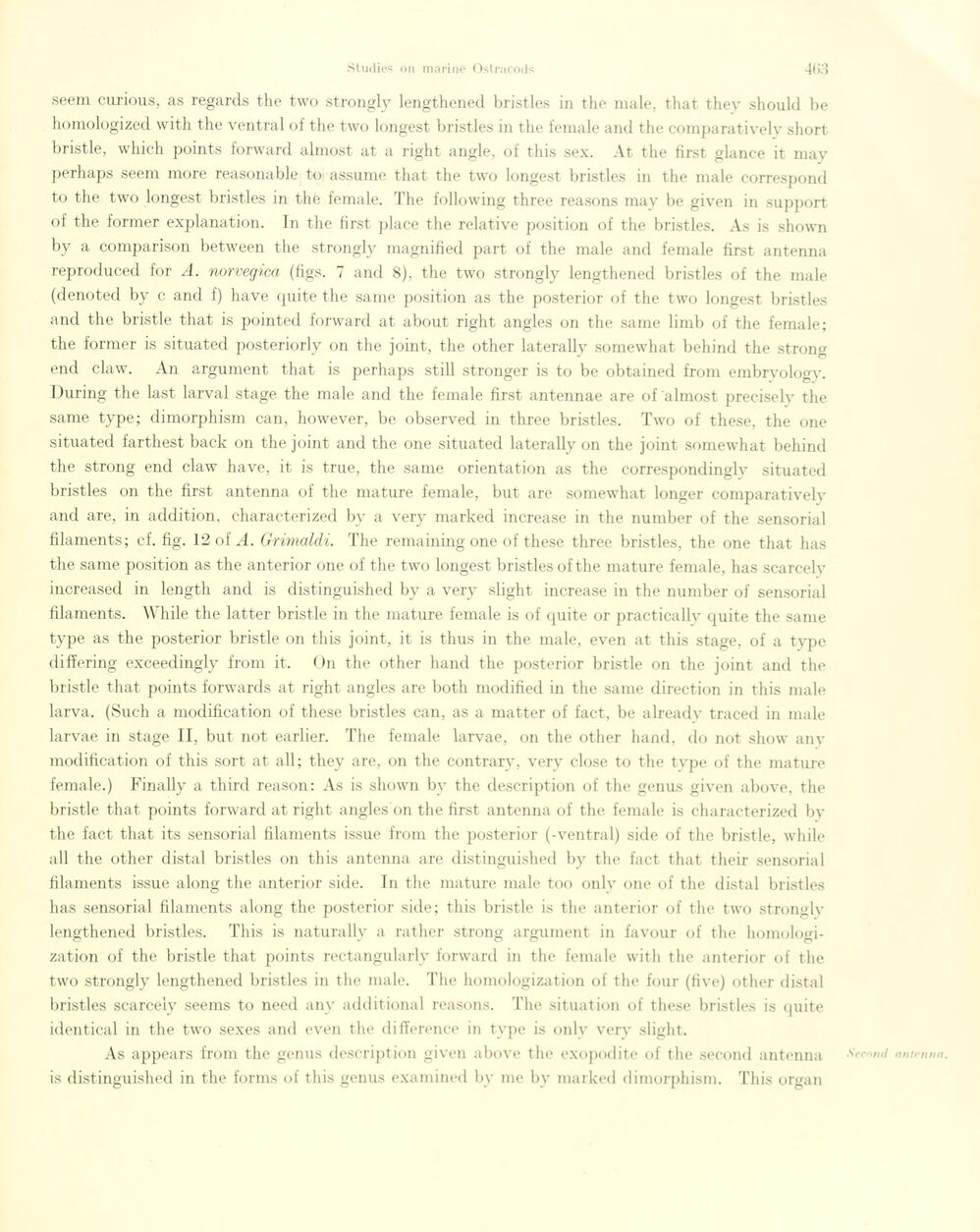
Full resolution (JPEG) - On this page / på denna sida - Sidor ...

<< prev. page << föreg. sida << >> nästa sida >> next page >>
Below is the raw OCR text
from the above scanned image.
Do you see an error? Proofread the page now!
Här nedan syns maskintolkade texten från faksimilbilden ovan.
Ser du något fel? Korrekturläs sidan nu!
This page has never been proofread. / Denna sida har aldrig korrekturlästs.
seem curious, as regards the two strongly lengthened bristles in the male, that they should be
homologized witb the ventral of the two longest bristles in the female and the eomparativelv short
bristle, vvliich points forward almost at a right angle, of this sex. At the first glance it may
perhaps seem more reasonable to assume that the two longest bristles in the male correspond
to the two longest bristles in the female. The following three reasons may be given in support
of the former explanation. In the first place the relative position of the bristles. As is shown
by a comparison between the strongly magnified part of the male and female first antenna
reproduced for A. norvegica (figs. 7 and 8), the two strongly lengthened bristles of the male
(denoted by c and f) have quite the same position as the posterior of the two longest bristles
and the bristle that is pointed forward at about right angles on the same limb of the female;
the former is situated posteriorly on the joint, the other laterally somewhat behind the strong
end claw. An argument that is perhaps still stronger is to be obtained from embrvologv.
During the last larval stage the male and the female first antennae are of almost precisely the
same type; dimorphism can, however, be observed in three bristles. Two of these, the one
situated farthest back on the joint and the one situated laterally on the joint somewhat behind
the strong end claw have, it is true, the same orientation as the correspondingly situated
bristles on the first antenna of the mature female, but are somewhat longer eomparativelv
and are, in addition, characterized by a very marked increase in the number of the sensorial
filaments; cf. fig. 12 of A. Grimaldi. The remaining one of these three bristles, the one that lias
the same position as the anterior one of the two longest bristles of the mature female, lias scarcelv
increased in length and is distinguished by a very slight increase in the number of sensorial
filaments. While the latter bristle in the mature female is of quite or practically quite the sanie
type as the posterior bristle on this joint, it is thus in the male, even at this stage, of a type
difîering exceedingly from it. On the other hand the posterior bristle on the joint and the
bristle that points forwards at right angles are both modified in the same direction in this male
larva. (Such a modification of these bristles can, as a matter of fact, be already traced in male
larvae in stage II, but not earlier. The female larvae, on the other hånd, do not show any
modification of this sort at ail; tliey are, on the contrary, very close to the type of the mature
female.) Finally a third reason: As is shown by the description of the genus given above, the
bristle that points forward at right angles on the first antenna of the female is characterized by
the fact that its sensorial filaments issue from the posterior (-ventral) side of the bristle, while
ail the other distal bristles on this antenna are distinguished by the fact that their sensorial
filaments issue along the anterior side. In the mature male too only one of the distal bristles
has sensorial filaments along the posterior side; this bristle is the anterior of the two strongly
lengthened bristles. This is naturally a rather strong argument in favour of the
homologi-zation of the bristle that points rectangularlv forward in the female with the anterior of the
two strongly lengthened bristles in the male. The homologization of the four (tive) other distal
bristles scarcely seems to need any additional reasons. The situation of these bristles is quite
identical in the two sexes and even the difference in type is only very slight.
As appears from the genus description given above the exopodite of the second antenna
is distinguished in the forms of this genus examined by me by marked dimorphism. This organ
Second nuten na.
<< prev. page << föreg. sida << >> nästa sida >> next page >>